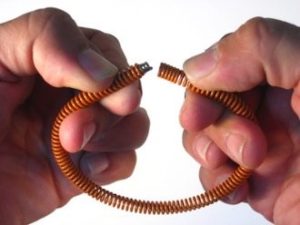 A garter spring is an extension spring that is coiled and connected together to form a circular shape. Here’s everything you need to know about this type of spring.
A garter spring is an extension spring that is coiled and connected together to form a circular shape. Here’s everything you need to know about this type of spring.
Applications
Most of these springs are used for shaft sealing or oil sealing because their circular shape allows them to withstand forces from all directions and maintain pressure in a cylinder or over a shaft. They can easily handle pressure, viscosity, and temperature changes and prevent contamination from water, dust, dirt, lubrication, and chemicals. Common uses for these springs in combination with the rubber sealing media include hydraulic pump seals, washing machine seals, gearbox seals, diesel engine seals, transmission seals, valve stem seals, off-road wheel seals, and shock absorbing seals, pinion seals. They’re used in the automotive industry, in electrical applications, motor belts, and other types of machines.
Extension and Compression
When designed and built for this purpose, you can join the male and female ends of extension springs or compression springs in order to create garter springs. Extension springs exert inward radial forces, while compression springs exert outward forces. Compression springs store energy when they’re compressed and exert kinetic energy once they are released. They are used inside circular objects.
Extension springs, on the other hand, exert forces toward the center. They store energy while extended and are typically used on the outside of a circular object. These types of springs are more commonly used due to their quick and efficient responses to change and because they required the use of less material, which is more cost effective.
Both types are typically made out of carbon steel, which yields high strengths and easily returns to its shape after a temporary deformity. However, when the garter spring is to be used in corrosive environments, stainless steel is used, which has higher chromium content by mass. Applications with substantially elevated temperatures normally require the use of Alloy steel.
Design Considerations
When designing a garter spring, many considerations need to be taken into account to ensure maximum functionality. Some of these factors to consider include the type of environment it will be placed in to determine the type of wire to use, the inner and outer diameters of the formed ring for a precise fit, and the maximum force that will be applied to the spring for optimal performance.
Manufacturing Process
Manufacturing this type of spring is similar to producing regular coiled springs. The only difference is the joining of the ends together at the end of the process. Once the design phase is finished, it takes four stages to produce such a spring. Firstly, cutting and coiling the reels of wire must be performed to create coiled springs. Secondly, the spring must be stress relieved in a high-temperature oven to optimize functionality. Third, the spring’s unique shape must be created by joining the ends together, either by interlocking the loops, using a short connector with a hook and loop, or reducing one end’s diameter to fit the other end. Lastly, the finishing touches must be applied, which include shot peening, setting, and coating. The different coating options you can choose from include black oxide, electro-plating, zinc plating, galvanized wire, and nickel-plating. Some designs to not allow the use of certain plating. Plating will add to the overall manufacturing cost but it might be a necessary component of the manufacturing process depending on your application.
If either you’re looking to produce extension garter springs or compression garter springs, your manufacturer can help you with all of the design and manufacturing stages so you get the right springs for your intended application.
Belt Tensioner Spring
Learn How We Helped an Automative Parts Manufacturer
Reduce Spring Cost by 20%
